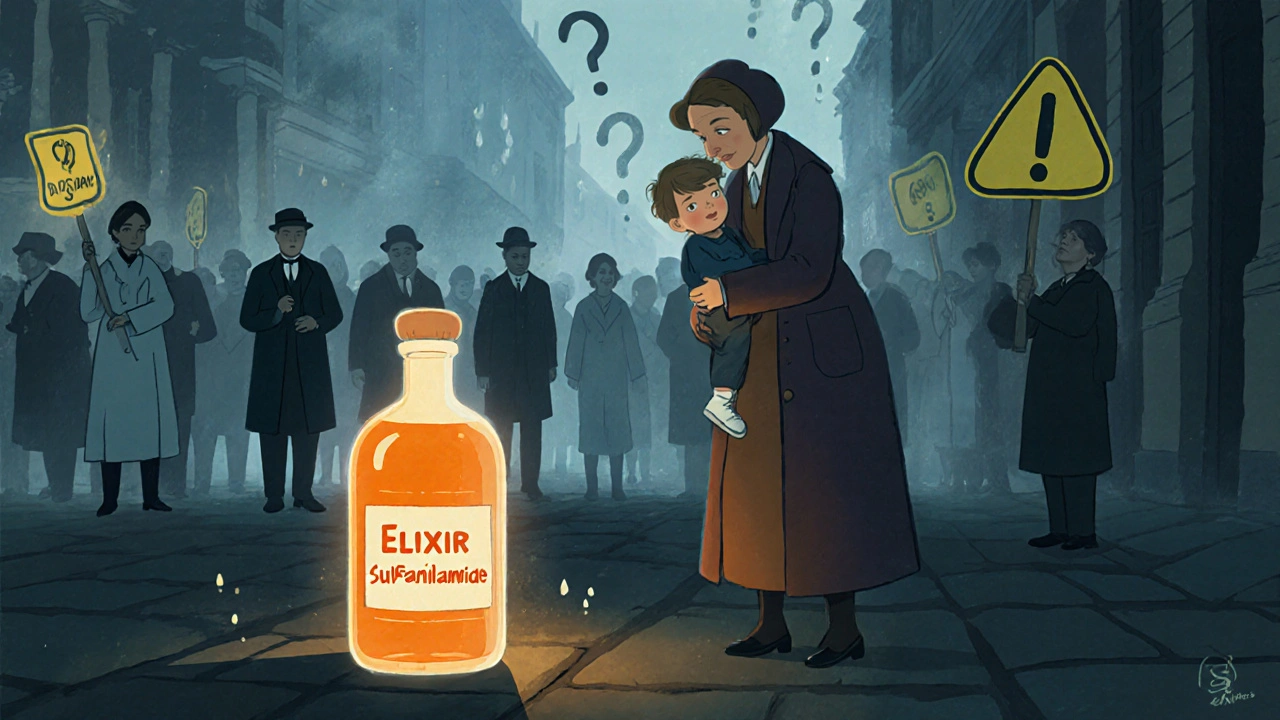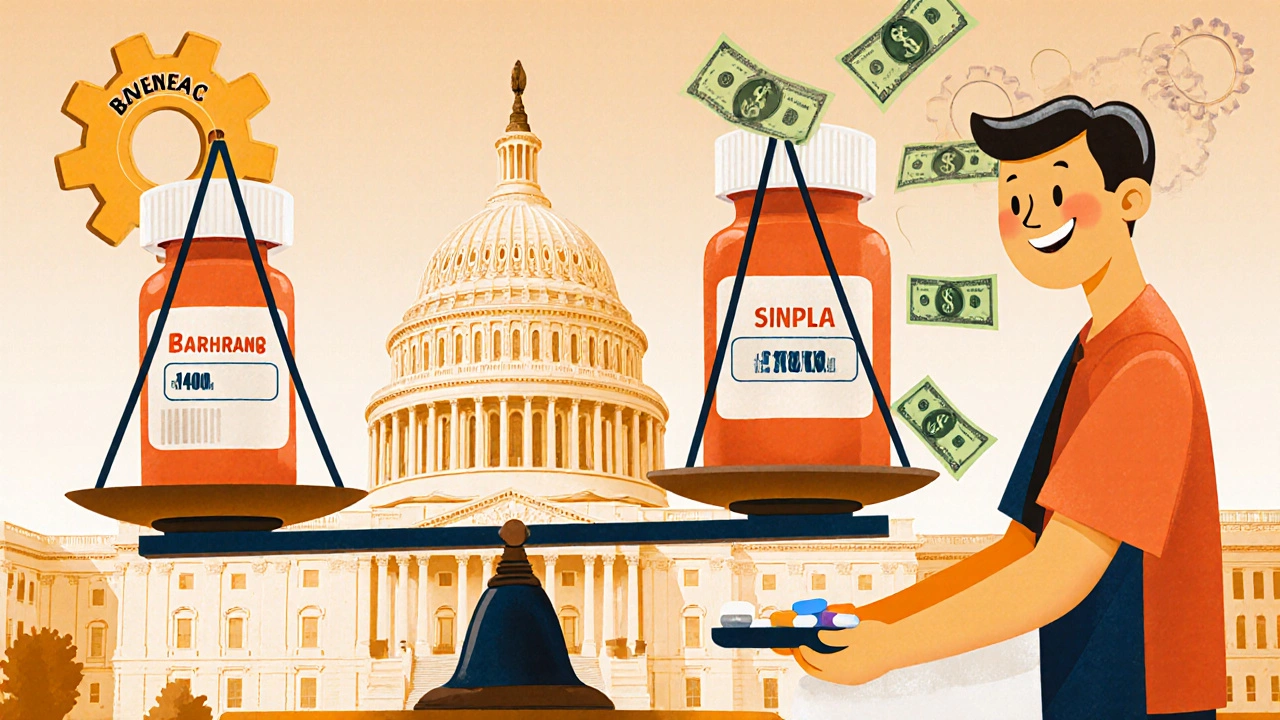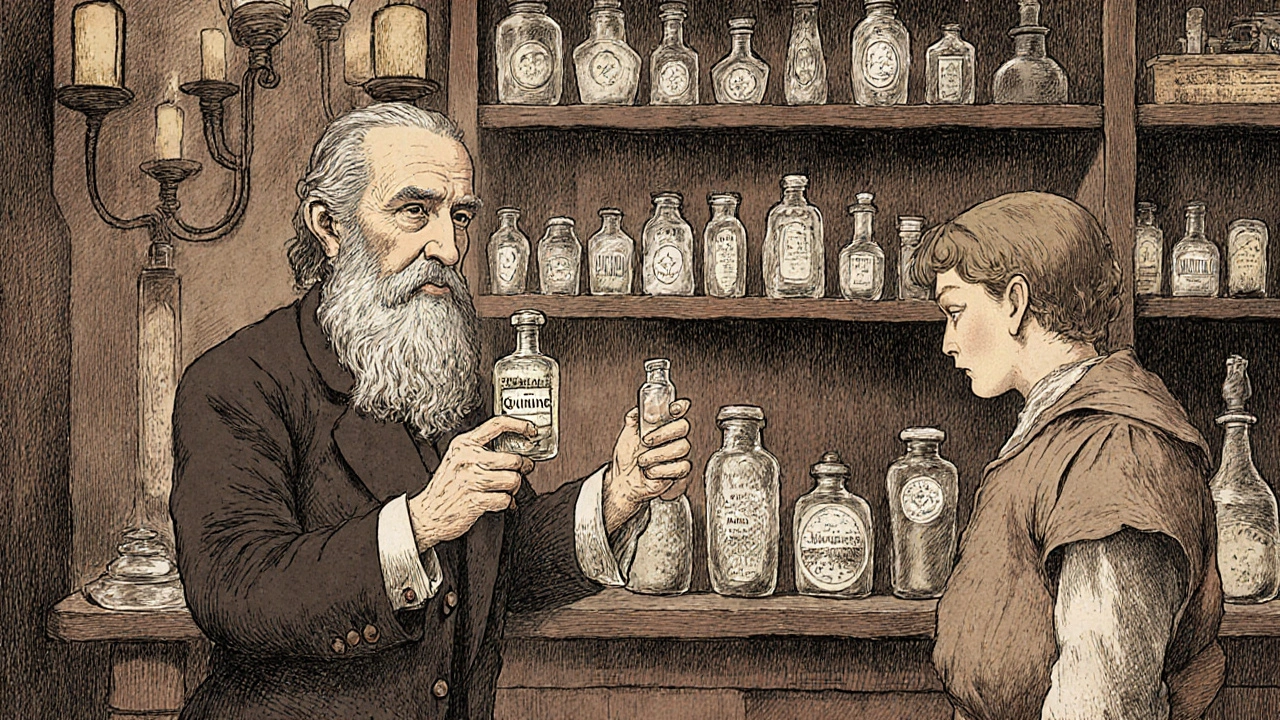Before you pick up a prescription, chances are you’re holding a generic drug. Today, more than 9 out of 10 prescriptions filled in the U.S. are for generics. But this wasn’t always the case. For most of the 20th century, brand-name drugs dominated the market - and prices were high because there was little competition. The rise of generic drugs didn’t happen by accident. It was the result of decades of legal battles, public health crises, and smart policy changes that put patient access and affordability at the center of drug regulation.
The Roots of Drug Standards: 1820-1906
The story of generic drugs in America starts long before anyone talked about "bioequivalence" or "ANDAs." In 1820, eleven doctors met in Washington, D.C., and created the first U.S. Pharmacopeia. Their goal? To stop pharmacies from selling fake or weak medicines. Back then, drugs were mixed by hand, and ingredients varied wildly. One bottle of quinine might have the right dose; the next could be barely active - or even poisonous. In 1848, Congress passed the Drug Importation Act, giving U.S. Customs the power to seize substandard drugs coming in from overseas. It was the first time the federal government stepped in to control drug quality. Then, in 1888, the American Pharmaceutical Association published the National Formulary, a standardized list of approved drug ingredients and formulas. These weren’t laws yet, but they laid the groundwork for consistency. The real turning point came in 1906, when President Theodore Roosevelt signed the Federal Food and Drugs Act. This law forced manufacturers to list ingredients on labels. No more hiding arsenic or alcohol in "tonics." It also banned false claims - like a medicine curing tuberculosis when it was just sugar water. This was the birth of the modern FDA, though it didn’t have the power to pull dangerous drugs off shelves yet.The Elixir Sulfanilamide Tragedy and the 1938 Law
In 1937, a pharmaceutical company released a new version of the antibiotic sulfanilamide - but instead of using a safe solvent, they used diethylene glycol, a toxic chemical found in antifreeze. The product, called Elixir Sulfanilamide, was sold over the counter. More than 100 people died, mostly children. The public outcry was immediate. That disaster led to the Federal Food, Drug, and Cosmetic Act (FDCA) of 1938. For the first time, drug companies had to prove their products were safe before selling them. The FDA gained real authority. But here’s the catch: the law didn’t require proof that drugs actually worked. It only required proof they wouldn’t kill you. So for decades, many drugs were on the market with no solid evidence they helped patients - brand-name or otherwise.The Kefauver-Harris Amendments: Proving Efficacy
By the early 1960s, another crisis hit. Thalidomide, a drug used for morning sickness in Europe, caused severe birth defects. In the U.S., it was mostly kept off the market thanks to an FDA reviewer named Frances Kelsey, who refused to approve it without better safety data. Her stand made headlines. In response, Congress passed the Kefauver-Harris Drug Amendments of 1962. This law changed everything. For the first time, drugmakers had to prove their products were not just safe, but effective. They had to run clinical trials. And here’s the key detail: all drugs approved between 1938 and 1962 had to go back through the review process. Thousands of drugs were pulled or reformulated. This was the moment when the idea of "equivalent" drugs began to take shape. If a brand-name drug had to prove it worked, then a copy should, too - right? But there was no easy way to make that happen. Copying a drug meant repeating expensive clinical trials. Most companies didn’t bother.
Medicare, Medicaid, and the Push for Cheaper Drugs
In 1965, Congress created Medicare and Medicaid. Suddenly, the government was paying for millions of prescriptions. And it was spending a lot of money - mostly on brand-name drugs. Health officials realized: if they could switch even a small percentage of prescriptions to cheaper versions, they’d save billions. But generics weren’t widely available. Why? Because the approval process was slow, unclear, and expensive. In 1967, Congress passed laws encouraging federal programs to use generic drugs whenever possible. But without a legal pathway, most pharmacists and doctors stuck with brands - out of habit, fear of liability, or lack of trust.The Hatch-Waxman Act: The Game Changer
The real revolution came in 1984 with the Drug Price Competition and Patent Term Restoration Act - better known as the Hatch-Waxman Act. Named after its sponsors, Senator Orrin Hatch and Representative Henry Waxman, this law created the modern system for generic drugs. Before Hatch-Waxman, only about 19% of prescriptions were for generics. After? That number jumped. Here’s how it worked:- Generic companies no longer had to repeat full clinical trials. Instead, they had to prove their drug was bioequivalent - meaning it released the same amount of active ingredient into the bloodstream at the same rate as the brand.
- They used the Abbreviated New Drug Application (ANDA), a faster, cheaper process.
- Brand-name companies got up to five extra years of patent protection to make up for time lost during FDA review.
- Generic manufacturers were given 180 days of market exclusivity if they were the first to challenge a patent.
The Rise of the Generic Market: 2000-2020
By the early 2000s, the FDA was overwhelmed. Thousands of ANDA applications were sitting in queues. Approval times stretched to 30 months. In 2007, the agency launched the Generic Initiative for Value and Efficiency (GIVE) to fix the backlog. Then came the Generic Drug User Fee Amendments (GDUFA) in 2012. For the first time, generic manufacturers paid fees to the FDA to fund faster reviews. The results? Review times dropped from 30 months to under 10 months. Approval rates jumped from 45% to 95%. The system started humming. Meanwhile, the market exploded. In 2022, generics made up 90.5% of all prescriptions filled in the U.S. - but only 23.4% of total drug spending. That’s the power of competition. A brand-name drug might cost $300 a month. The generic? $10. The Association for Accessible Medicines estimates generics saved the U.S. healthcare system $373 billion in 2021 alone. Over the past decade, that’s over $3.7 trillion in savings.
Problems in the System: Price Gouging and Shortages
Despite all the progress, the generic drug industry has serious flaws. One big issue: price spikes. Between 2013 and 2017, the price of 15% of generic drugs jumped more than 100%. Why? Because some markets became too concentrated. If only two companies make a certain generic - and one quits - the other can raise prices. That’s what happened with drugs like doxycycline and penicillin. Some generics went from $20 a bottle to $1,800. Another problem: drug shortages. Between 2018 and 2022, the FDA recorded 1,234 shortages. Sixty-five percent involved generic drugs. Why? Because most active ingredients come from factories in China and India. When a natural disaster, political issue, or quality failure hits one plant, supply chains break. The FDA says 80% of API (active pharmaceutical ingredient) facilities are overseas. And then there’s the loophole: patent abuse. Brand-name companies sometimes sue generic makers just to trigger a 30-month delay. Even if the patent is weak, the lawsuit stops the generic from entering the market. The FDA has taken action under the CREATES Act - 27 enforcement actions as of 2022 - but it’s still happening.What’s Next? Biosimilars and Global Supply Chains
The next frontier isn’t small-molecule generics anymore. It’s biosimilars - cheaper versions of complex biologic drugs like Humira or Enbrel. These aren’t simple copies. They’re made from living cells, so they’re harder to replicate. But they’re also way more expensive - often $10,000 a year. Biosimilars could cut those costs by 70% or more. The FDA approved its first biosimilar in 2015. Since then, more have followed. But adoption is slow. Doctors and patients still hesitate. Insurance companies don’t always push them. The system isn’t fully ready. As for supply chains, the U.S. government is finally paying attention. The pandemic exposed how dangerous it is to rely on just a few foreign factories. New policies aim to bring some API production back to the U.S. or to allied countries. But it’s expensive and slow.Why It Matters
The history of generic drugs in the U.S. is a story of public health triumph - but also of missed opportunities and corporate loopholes. Without the Hatch-Waxman Act, millions of Americans couldn’t afford their medicines. Without the FDA’s reforms, the system would still be clogged with paperwork. Today, generics are the invisible backbone of American healthcare. They’re not "inferior." They’re not "cheap substitutes." They’re identical in every way that matters: active ingredient, dose, safety, and effect. The only difference? Price. And that’s the point. The system works best when competition is allowed. When companies can make the same drug without paying for someone else’s research. When patients aren’t forced to pay for a brand name they don’t need. The challenge now is to fix the cracks - stop price gouging, secure supply chains, and make sure biosimilars get the same fair shot as generics did in the 1980s. Because if we do, the next 40 years could be even better than the last.Are generic drugs as safe as brand-name drugs?
Yes. The FDA requires generic drugs to have the same active ingredient, strength, dosage form, and route of administration as the brand-name version. They must also meet the same strict quality, purity, and potency standards. Generic manufacturers are inspected just like brand-name companies, and their products are held to the same testing requirements. The only difference is the inactive ingredients - like fillers or dyes - which don’t affect how the drug works.
Why are generic drugs so much cheaper?
Generic drugs cost less because manufacturers don’t have to repeat expensive clinical trials. Once a brand-name drug’s patent expires, other companies can use the existing safety and efficacy data to get approval through the Abbreviated New Drug Application (ANDA) process. This cuts development costs dramatically. Generic companies also compete with each other, which drives prices down further. On average, generics cost 80-85% less than their brand-name counterparts.
Can a generic drug look different from the brand-name version?
Yes, and that’s normal. U.S. law requires generics to look different from brand-name drugs to avoid trademark infringement. So a generic version of a blue pill might be white or oval-shaped. But the active ingredient, dose, and how it works in your body are identical. The color, shape, or taste doesn’t change the drug’s effectiveness.
Why do some generic drugs have price spikes?
Price spikes happen when there’s little competition. If only one or two companies make a certain generic, and one stops production - due to low profit margins, quality issues, or supply chain problems - the remaining company can raise prices. This has happened with older, low-cost drugs like doxycycline, insulin, and albuterol. The FDA and Congress have tried to fix this with laws like CREATES, but market concentration remains a problem.
Are most generic drugs made in the U.S.?
No. About 80% of the active pharmaceutical ingredients (APIs) used in U.S. generic drugs come from facilities in China and India. Final packaging and some manufacturing may happen in the U.S., but the core chemical components are largely imported. The FDA inspects these foreign facilities, but supply chain vulnerabilities remain a concern, especially after pandemic-related disruptions.


Comments
Shawn Daughhetee
I've been on generics for years and never had an issue. My blood pressure med? Same as the brand, half the price. No drama, just works.
Simple as that.
November 24, 2025 at 08:45
Patrick Marsh
The Hatch-Waxman Act was a masterstroke. Without it, insulin would still cost $500 a vial. And no, the FDA doesn't cut corners on generics.
November 26, 2025 at 05:20
Miruna Alexandru
It's fascinating how policy shapes biology. The bioequivalence standard isn't just regulatory-it's epistemological. We're not measuring chemical identity, we're measuring physiological equivalence in vivo. And yet, society treats generics as 'lesser' because of aesthetics. The placebo effect is a real drug, and it's being weaponized by brand marketing.
Meanwhile, the global supply chain for APIs remains a geopolitical vulnerability masked as efficiency. We outsourced our pharmaceutical sovereignty for cost savings, and now we're surprised when a cyclone in Gujarat disrupts metformin supplies to Ohio. This isn't capitalism-it's fragility dressed up as innovation.
November 27, 2025 at 05:29
manish chaturvedi
In India, we know generics well. Many of us rely on them daily. The quality control may surprise you-some Indian manufacturers supply to the FDA and EU with higher compliance rates than some U.S. plants. It's not about where it's made, but who's overseeing it.
And yes, the price difference is real. A month's supply of metformin here costs less than a cup of coffee. That's not a flaw-it's justice.
November 28, 2025 at 08:58
ann smith
I just want to say thank you for writing this. 💙 As someone who has to choose between rent and meds, knowing the history behind generics gives me hope. They're not second-rate-they're second-to-none. Keep fighting for affordable care!
November 28, 2025 at 23:06
Julie Pulvino
I used to think generics were sketchy until my dad started taking them after Medicare. He was skeptical too. Then he saw the receipt: $12 vs $310. He said, 'If it's good enough for the government to pay for, it's good enough for me.' He's been fine for five years now. Sometimes the system actually works.
November 30, 2025 at 21:37
Danny Nicholls
just wanted to say i love how this article breaks it down 😊 i had no idea about the ANDA process or how much we’ve saved over the years. also the part about biosimilars? mind blown. we need more of this stuff in the mainstream!
December 2, 2025 at 02:18
Mark Williams
The GDUFA framework represents a paradigm shift in regulatory economics. By introducing user fees, the FDA transformed from a constrained public agency into a self-sustaining operational entity with measurable throughput KPIs. This incentivized efficiency without compromising safety standards-a rare example of public-private synergy in pharmaceutical governance.
December 2, 2025 at 02:57
Latonya Elarms-Radford
Let’s be honest. The entire generic drug system is a tragic farce wrapped in bureaucratic elegance. We celebrate the 'savings' while ignoring that the same corporations that monopolized brand-name pricing now monopolize generics. The 180-day exclusivity window? That’s not competition-that’s a cartel handshake. And don’t get me started on the FDA’s 'inspection' of overseas facilities. They send one auditor to a plant that employs 2,000 people and call it 'due diligence.'
Meanwhile, we’re told to be grateful that our doxycycline costs $15 instead of $1,800. That’s not progress. That’s survival with a smiley face sticker on it.
December 4, 2025 at 01:26
Holly Schumacher
I work in pharmacy. I’ve seen people cry because they can’t afford their brand. I’ve seen them take half-doses because they can’t afford the generic. I’ve seen the same exact pill-same manufacturer, same batch, same everything-sold under two different labels with a 10x price difference. This isn’t about science. It’s about greed. And the system lets it happen.
December 5, 2025 at 07:11
Robin Johnson
This is exactly the kind of deep-dive we need. You didn’t just explain the history-you showed why it matters. If you’re reading this and thinking 'it’s just a pill,' think again. This is life or death for millions. Keep pushing this narrative.
December 6, 2025 at 05:37
Ravi Kumar Gupta
In India, we call them 'copy drugs' and they’re the backbone of our public health system. But here’s the twist-we export them to Africa and the U.S. while our own poor still wait in lines. The same system that saves Americans money keeps our villagers waiting. Global justice isn’t just a slogan-it’s a supply chain.
December 8, 2025 at 01:44
Daniel Jean-Baptiste
i read this on my phone at the clinic while waiting for my refill. the part about biosimilars really stuck with me. we need to get behind those like we did with generics. also thanks for not calling them 'cheap'-they're smart. and yeah the supply chain thing is scary but we can fix it if we try
December 9, 2025 at 12:51
Nikhil Chaurasia
I’ve worked with generic manufacturers in Hyderabad. The labs are clean, the engineers are brilliant, and the quality control is stricter than most American mom-and-pop pharmacies. The real scandal isn’t the product-it’s the narrative that says 'Made in India = unsafe.' That’s prejudice dressed as caution.
December 9, 2025 at 22:28
Write a comment